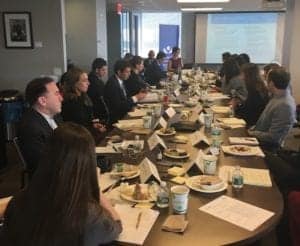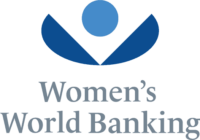Even in 2017, 1.1 billion women worldwide, a third of the global population, don’t have access to financial services. And while financial inclusion is trending up, the gender gap hovers stubbornly around 9 percent in developing economies. Digital financial services offer the most promising avenues for closing that gap, but has yet to reach scale. How can we leverage existing solutions, as well as the innovative, exciting new models in the market today? How do we most effectively partner with allies to serve more women as quickly and sustainably as possible? Women’s World Banking convened the “Going Digital: The Key to Women’s Financial Inclusion?” roundtable, sponsored by the ExxonMobil Foundation, to discuss how those in the business of financial inclusion can and should proceed to ensure women are part of the digital future.
The event convened representatives from public and private sectors, including government ministries, philanthropic organizations and financial institutions. As Women’s World Banking President and CEO Mary Ellen Iskenderian noted in her opening remarks, the diversity of stakeholders “is a testament to just how much ‘digital’ has become inextricably linked to our shared goal of women’s financial inclusion.” Leveraging digital financial services to help close the gender gap is not a mission that any organization, government or financial institution can pursue alone; it requires buy-in and ongoing commitment from every sector.
Digital financial services for women – where are we now?
Anna Gincherman, Chief Product Development Officer at Women’s World Banking, shared some of the best practices collectively achieved so far in digital financial services for women. For example, designing products that meet women’s needs such as easy-to-open savings accounts with tiered KYC (Know Your Customer) processes and reaching women where they are and earning their trust. But pricing products correctly, training staff to better serve women, and driving sustainable engagement among women clients remain sizable challenges, ones we must overcome in order to achieve scale.

Opportunity in G2P (government-to-person) payments
Some of Indonesia’s strategies involve traditional programs such as group savings accounts and the Mekaar microfinance program aimed at women. But Indonesia is also exploring new digital approaches for targeting women individually instead of in groups. For instance, government rice disbursements typically go to the head of household, usually male. Today, money transfers go directly to the women digitally, through a government-issued “combo card” as part of its expanded commitment to offering women more convenient digital banking options and increasing financial inclusion.
“‘Digital’ has become inextricably linked to our shared goal of women’s financial inclusion.”
– Mary Ellen Iskenderian
Mexico’s G2P challenge is one of lagging engagement. Eduardo Clark, Director of Digital Inclusion for the Office of the Presidency of Mexico, explained how Prospera, the country’s groundbreaking conditional-cash transfer program, is attempting to expand digital disbursement to qualifying families, with support from the Bill & Melinda Gates Foundation. Only 21 percent (1.5 million) of the approximately 7 million families enrolled in Prospera receive their transfers by debit card. According to Clark, one of the main issues is that women using the debit card typically don’t know it’s a bank account too, and they tend to withdraw the full transfer amount within a few days. The next step will be to encourage debit card recipients to see the potential of those accounts as a digital gateway to help them save, build assets and achieve greater financial inclusion.
Incentives for inclusion
In Nigeria’s private sector, Diamond Bank has successfully reached unbanked low-income women with its BETA Savings account, developed with Women’s World Banking. With convenient account access through a network of mobile agents and affordable pricing structure, BETA Savings sees a 40 percent growth year-over-year since 2012. Currently, 37 percent of BETA Savings customers are women, and as Olukayode Olubiyi, Head of Financial Inclusion for Diamond Bank, explained at the roundtable, the bank introduced a new incentive scheme to increase that percentage. BETA agents will receive cash rewards, higher commissions, and incentives such as dinners with Diamond Bank executives for bringing in more women clients. The rewards “will continue on a monthly basis to help us grow inclusion,” Olubiyi added.
No women focus, no women reached
 Some of the most forward-thinking digital innovations discussed in the roundtable were not specifically designed for women, which reinforced the need to ensure that women are not left behind in the digital age. Our work over the years shows that one-size-fits-all services tend not to work for a significant proportion of women. As Nangi Massawe, Assistant Manager of Real Sector and Financial Inclusion at the Bank of Tanzania, highlighted: a more tailored approach that addresses women’s unique needs and preferences as well as gender disaggregated data—such as the data now required for all savings providers in Tanzania—will help us identify digital solutions that have “stickiness” for women clients. Financial technology startups are leveraging data science and behavioral design to create user experiences that transform mere access into meaningful financial inclusion. For instance, a participating fintech firm shared their idea that there are a number of non-financial activities women will use digital technology for and these can be used as gateways for uptake as well as drivers of usage, such as mobile phone top-up.
Some of the most forward-thinking digital innovations discussed in the roundtable were not specifically designed for women, which reinforced the need to ensure that women are not left behind in the digital age. Our work over the years shows that one-size-fits-all services tend not to work for a significant proportion of women. As Nangi Massawe, Assistant Manager of Real Sector and Financial Inclusion at the Bank of Tanzania, highlighted: a more tailored approach that addresses women’s unique needs and preferences as well as gender disaggregated data—such as the data now required for all savings providers in Tanzania—will help us identify digital solutions that have “stickiness” for women clients. Financial technology startups are leveraging data science and behavioral design to create user experiences that transform mere access into meaningful financial inclusion. For instance, a participating fintech firm shared their idea that there are a number of non-financial activities women will use digital technology for and these can be used as gateways for uptake as well as drivers of usage, such as mobile phone top-up.
One powerful message rang clear throughout the day: A diverse ecosystem of stakeholders is crucial if digital financial services for women are to succeed and reach scale. We look forward to continued partnerships and convenings with the roundtable participants to ensure that our innovations deliver on the promise of digital financial services for women.



